Chapter 6. Working with Multiple Tables
In this chapter
Multitable Systems in FileMaker Pro
Creating a One-to-Many Relationship in FileMaker
Creating a Many-to-Many Relationship
Multitable Systems in FileMaker Pro
This chapter shows you how to take the ideas from Chapter 5, “Relational Database Design,” and use them to build FileMaker database systems. You’ll learn how to use FileMaker to create database systems that model the types of relationships covered in Chapter 5. In general, we don’t like to prescribe a linear path through this book, but for this chapter (and really the one following, as well), we’re going to assume that you either have read Chapter 5 or have a reasonable familiarity with the terms and concepts of relational database design. If terms such as entity-relationship diagram, primary key, foreign key, and one-to-many relationship are unfamiliar to you, we recommend that you review Chapter 5 before proceeding here.
Chapter 5 laid out a set of design concepts that centered around the ideas of entities, their attributes, and the relationships between entities. In FileMaker Pro, you’ll generally represent a database entity (“student,” for example) as a table. You’ll generally represent an entity’s attributes (“first name,” “year of graduation,” for example) by the fields of that table. And you’ll create relationships among tables with FileMaker’s Relationships Graph, a tool we’ll be showing you in this chapter.
Before you get into the meat of this chapter, it’s a good idea to review FileMaker’s default behavior when you create a new database. When you create a new database, FileMaker creates a database with just one table in it, and that table initially has the same name as the name you gave the database as a whole. This is a sensible default behavior if you only ever intend to work with one table in the given database.
But FileMaker also has facilities for adding more tables to a system, adding different fields to each table, and creating many kinds of relationships between tables. We explore these tools in the context of some of the fundamental relationship types discussed in Chapter 5.
The focus of this chapter is on implementing the relational model. Further chapters on layout design help you with additional interface features and modifications to the basic layout.
This chapter builds a small FileMaker database solution that uses the same basic data model used in the Task Management Starter Solution.
The sequence of steps involved in building a database solution such as this varies from person to person. Some people prefer to build the tables first and then add the fields and their options. Other people, knowing the basic fields used in each table, prefer to create a table with its fields and options and then move onto the next one. Do whatever makes most sense to you, realizing that FileMaker database development, more than most database development, is an iterative process. The only necessity is that to create a relationship in the Relationships Graph, you must have the two tables involved and the two fields that will be used as the primary and foreign key.
Creating a One-to-Many Relationship in FileMaker
In the Small Task Management database, there are going to be three basic tables. Each table will have the five basic fields previously mentioned. Each is auto-entered by FileMaker Pro and none can be modified by the user during data entry. To show the database structure more clearly in this chapter, only zID is shown in the figures.
- zID— This is the auto-entered serial number. Because it is auto-entered and unique, you can use it as the primary key of each record in each table of the database.
- zCreator— This is the name of the creator of the record. It could be set to the account name if you prefer.
- zModifier— This is the name of the last modifier of the record. It could be set to the account name if you prefer.
- zCreationTS— This is the creation timestamp of the record.
- zModificationTS— This is the last modification timestamp of the record.
If you are using FileMaker Pro 9 Advanced, you can create a table with these fields, and copy and paste it for each new table you create. Or you can create the fields in a single table and copy and paste them into other tables.
These are the tables:
- Tasks— Each task has a name, a type of task, and a due date. Each task belongs to a single project.
- Projects— Each project has a name. It is related to zero or more tasks.
- Contacts— These are people or organizations who are assigned to tasks. Each contact can be assigned to zero or more tasks; each task can have zero or more contacts assigned to it.
Each entity in an entity-relationship diagram (ERD) generally translates into one table in a FileMaker system. The following sections describe how to begin.
Creating the First Table in a Multitable System
When you create a FileMaker database for the first time, you get a single table with the same name as the database. If you create a new database called Small Task Management, you’ll get within it a single table, also called Small Task Management, and the option to add fields to that table. For a multitable solution, the first step might be to rename the first table. Figure 6.1 shows the first table selected in the Manage Database dialog; its name is about to be changed to Tasks.
Figure 6.1. Rename the first table.
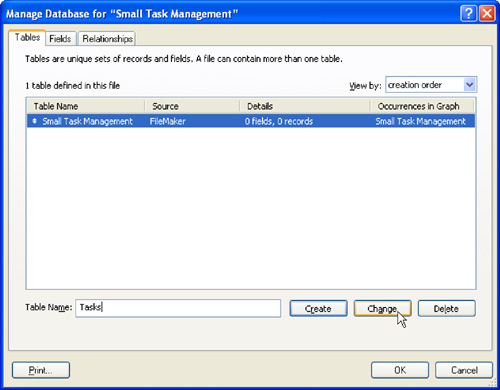
In Figure 6.2, you can see four fields created in the newly renamed Tasks table. They are the primary key, zID, the due date for the task, the type of the task, and the foreign key that will identify the project in the project table when that is created. Later, there will also be the other four basic timestamp and identification fields described previously.
Figure 6.2. Field definitions for an initial table in a database of Tasks information.
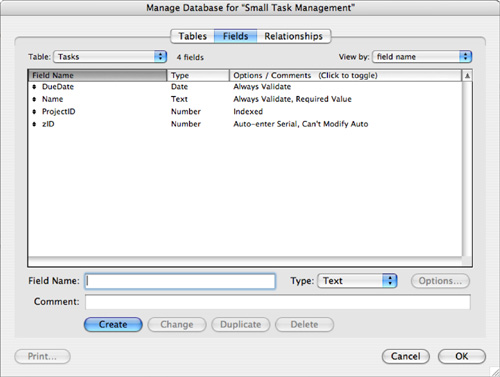
![]() For a refresher on the details of creating fields within a single table in FileMaker, see Chapter 3, “Defining and Working with Fields and Tables,” p. 87.
For a refresher on the details of creating fields within a single table in FileMaker, see Chapter 3, “Defining and Working with Fields and Tables,” p. 87.
Adding a Table to a Multitable System
That takes care of the Tasks table. To add a table for Projects, stay in the Manage Database dialog, but switch to the Tables tab. You’ll see just one table, which in this example is called Tasks. To add a new table, type the name in the Table Name box and click Create, and the new table will be added to the list. This will be the Projects table, as shown in Figure 6.3.
Figure 6.3. FileMaker’s Tables view, showing a database with multiple tables.

You’re now free to add fields to the new table. Figure 6.4 shows the basic starting fields for the Projects table.
Figure 6.4. Field structure for a table of projects.
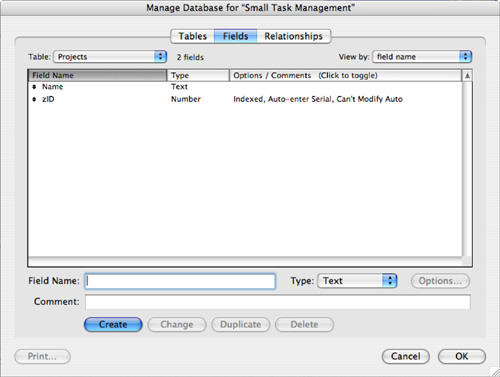
The Projects table automatically has a primary key (as do all tables that have an auto-entered zID serial number). It does not need a foreign key as the tasks table does. The next section shows you why.
![]() For a refresher on primary and foreign keys, see “Understanding the Role of Keys in Database Design,” p. 179.
For a refresher on primary and foreign keys, see “Understanding the Role of Keys in Database Design,” p. 179.
Adding a Relationship
There are now two tables, as well as the primary and foreign keys that good database design demands. To create a relationship between these two tables, move to the Relationships tab of the Manage Database dialog. This window, known as the Relationships Graph, should have a couple of graphical elements already displayed. Each one represents one of the database tables that exist in this database. These elements are known as table occurrences. Each shows the name of the table it represents, along with that table’s fields.
Adding a relationship between these two table occurrences is simple: Draw a line from ProjectID in the Tasks table to zID in the Projects table. You can also draw it in the other direction, from zID in the Projects table to ProjectID in the Tasks table. Relationships have no direction in FileMaker Pro. You should see a line extend from one table to the other. When you release the mouse, FileMaker creates the relationship and displays it as a link between one or more match fields at the top of the table occurrence pair. Figure 6.5 shows how the Graph will look as a result.
Figure 6.5. FileMaker’s Relationships Graph, with a relationship between two table occurrences.

You might have noticed the crow’s-foot at the end of the relationship line where it touches the Projects table occurrence. This is none other than the indicator that you’re accustomed to seeing on the ERDs from the preceding chapter. It’s intended to indicate the “many” side of a one-to-many relationship. Be warned, though! FileMaker provides this graphical adornment as a kind of a hint or guess about the relationship—it might not always be accurate, though in this case it is. We explain that point fully in the next section, where we discuss the creation of key fields in FileMaker.
At this point you’ve seen how to add a new table to FileMaker’s default one-table database configuration and how to define a one-to-many relationship between two FileMaker tables. The next sections clarify some important points about multitable systems.
Working with Keys and Match Fields
You should remember from Chapter 5 that keys are table fields—fields that are essential elements in forming the relational structure of a multitable system. FileMaker takes a somewhat broader view of keys, as you’ll see, and for that reason these fields are referred to as match fields when you’re working in a FileMaker context. A match field in FileMaker is any field that participates in a relationship between two FileMaker tables. Primary keys and foreign keys fit this definition, of course, but so do a number of other types of fields explored in the next chapter.
![]() For more on the broader uses of match fields in FileMaker Pro, see “Relationships as Queries,” p. 218, as well as other sections of Chapter 7, “Working with Relationships,” p. 217.
For more on the broader uses of match fields in FileMaker Pro, see “Relationships as Queries,” p. 218, as well as other sections of Chapter 7, “Working with Relationships,” p. 217.
Key fields (which form the structural backbone of the system) need to play by some special rules—especially primary keys. Consider the current example, the Small Task Management database system, and consider the zID field in the Projects table. This field has been identified as the primary key for the Projects table. To play the role of primary key, it must have a unique value. This was done automatically when you made it an auto-enter serial number in the Field Options dialog; it was further implemented by forcing it to have a unique value in the Validation tab and not allowing the user to modify it during data entry.
![]() For a discussion of cardinality, see “Relationship Cardinality,” p. 174.
For a discussion of cardinality, see “Relationship Cardinality,” p. 174.
The Database So Far
At this point, you have created two tables and added fields to each of them. You have used the Manage Database dialog to create a relationship between them. You have also created two default layouts—or at least FileMaker Pro has done it automatically for you while you were working in the Manage Database dialog. Figure 6.6 shows the Projects layout created for you. The order of the fields in the layout reflects the sequence in which you created them.
Figure 6.6. FileMaker Pro has created two layouts for you.
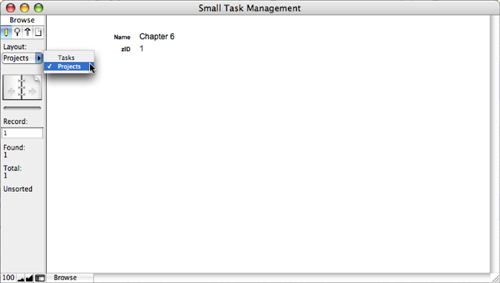
You can create a new record by choosing New Record from the Records menu in Browse mode. The serial number (1) will be automatically filled in, and you can type a project name such as Chapter 6.
Working with Related Data
So far in this chapter you’ve learned how to create additional tables in a FileMaker system and how to build relationships between those tables based on well-constructed match fields. This section shows you how to begin to use your relationships to work with and create data in multiple tables at once.
Using a Portal to View Related Child Data
The Small Task Management database system has two tables in it now, and there is a relationship between Projects and Tasks. In this example, a single record has now been created in the Projects table.
Now it is reasonable to create tasks for the project and to display them. You can do this with a FileMaker layout element called a portal. A portal lets you display multiple related records for a parent record in a layout.
Although nothing prevents you from using a portal to display a one-to-one relationship, its design is optimized for the display of multiple records in a one-to-many relationship. The context or base table for the layout in which a portal is placed should be the “one” side of the relationship; the portal will be the “many” side. You can have multiple portals in a single layout, but they will all be the many sides of various relationships of which the base table is the “one.”
![]() For additional discussion of the parent/child naming convention, see “One-to-Many Relationships,” p. 197.
For additional discussion of the parent/child naming convention, see “One-to-Many Relationships,” p. 197.
To create a portal on the Projects layout, choose the portal tool from the Status Area tools in Layout mode, as Figure 6.7 shows, and draw the portal in the approximate location you want it on the layout.
Figure 6.7. This is a layout in Layout mode, showing the FileMaker portal tool.
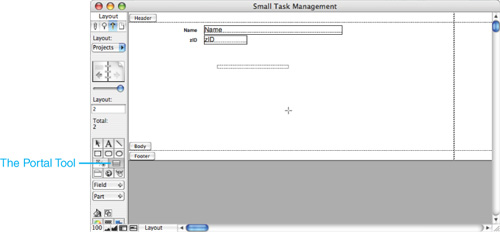
Click once on the tool, and then, on the layout, drag out a box wide enough to show the Task information and release the mouse. You’ll get a dialog box asking for details about the portal’s contents, behavior, and display. The dialog is shown in Figure 6.8.
Figure 6.8. FileMaker’s Portal Setup dialog.
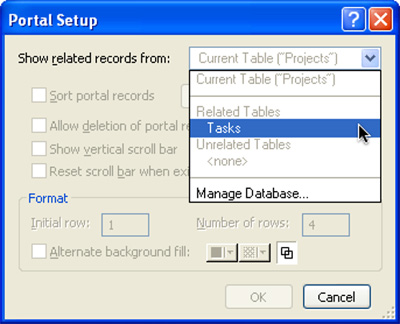
In general, when you set up a portal for the first time, you’ll need to do the following:
- Choose a table occurrence from which to display data
- Choose additional portal options
- Choose data fields for display in the portal
More details on each of these steps follow.
First, you need to specify where the portal gets its data. In the Portal Setup dialog, the Show related records from list enables you to choose which table to draw data from. The list is divided into sections: one for related tables and one for unrelated tables. (The Relationships Graph determines the question of whether a table is related or unrelated.) In the current example, for a portal on a layout in which the table context is the Projects table, there should be only one available choice in the menu: the Tasks table, which is the only other table related to Projects in the Relationships Graph. By choosing Tasks from this menu, you’re instructing FileMaker to show you all Tasks records related to the currently visible Projects record.
The Portal Setup dialog contains a number of other choices as well. For now, you can opt to display just 12 portal rows, and put a vertical scrollbar on the portal so that you can scroll down if a project has more than 12 tasks. You can also apply coloring or striping to the portal if you choose.
FileMaker also displays a dialog at the end of the portal creation process, asking which fields from the related table you want to show in the portal as shown in Figure 6.9.
Figure 6.9. The Add Fields dialog shows the available fields in the related table.
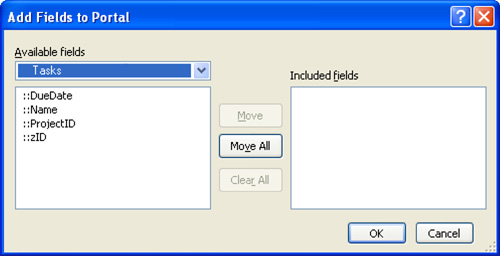
You can double-click field names or select them and click Move to add fields to the portal. As with everything else in the portal design, you can come back later to make modifications if you want. Note also that the pop-up menu at the upper left of the Add Fields dialog lets you select other related fields to display in the portal. When you have added fields to the portal list on the right, you can rearrange them by dragging the double-headed arrows up or down (see Figure 6.10).
Figure 6.10. Reorder portal fields if necessary.
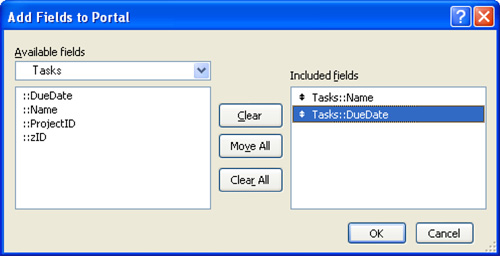
The Portal Setup dialog can be reopened by double-clicking the portal itself. Doing so will let you make other changes. You could, for example, click the Sort button to sort the data displayed in the portal as shown in Figure 6.11. Here, the data is sorted in descending order by date due (most recent first).
Figure 6.11. You can sort portal data.
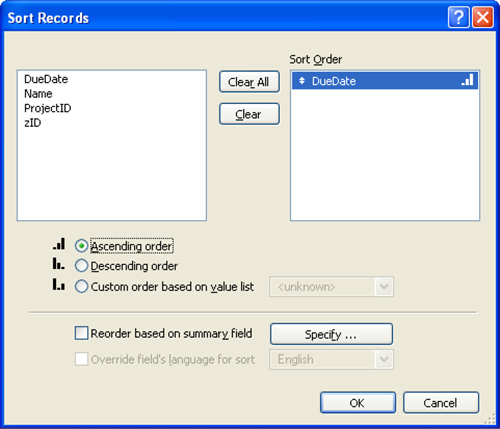
In addition to sorting the portal, you usually want to add a scrollbar to it in the Portal Setup dialog. A check box lets you do this, as shown in Figure 6.12.
Figure 6.12. The Portal Setup dialog lets you control where the data comes from, how it is sorted, and whether there is a scrollbar.
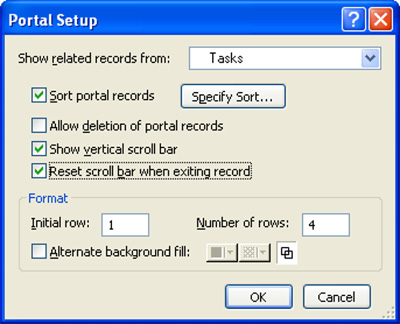
The automatic addition of fields to a portal row is done the first time the Portal Setup dialog is shown, immediately after you have drawn the portal. Thereafter, you need to add them manually.
Now that you have set up your portal, you are ready to enter related records.
Using a Portal to Add Related Records
You can use portals for data entry as well as data viewing. It’s possible to configure the portal and its underlying relationship so that a user can add Tasks to a Projects record by typing directly into the portal rows. To accomplish this task, you need to edit the relationship between Tasks and Projects. On the Relationships Graph, double-clicking the relationship line between the two tables brings up the Edit Relationship dialog, shown in Figure 6.13.
Figure 6.13. The Edit Relationship dialog is where you can edit individual relationships in the Relationships Graph.
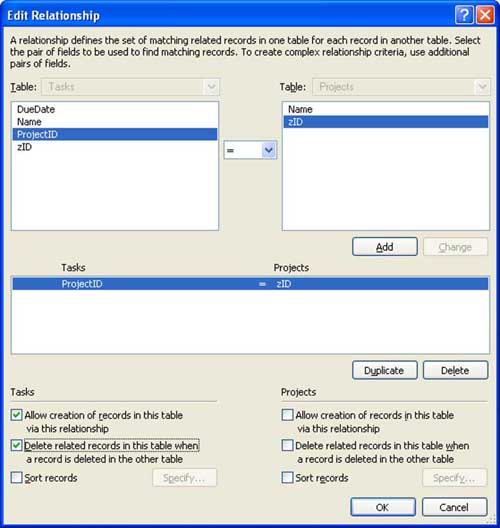
For each table participating in a relationship, there’s a Allow Creation of Records in This Table via This Relationship check box under it. If you check this box on the Tasks side of the dialog, it becomes possible to create task records via this relationship. You also can choose to delete related records automatically, which in this case is a good idea. You cannot have a task without an associated project, so if the project is deleted, all its tasks should be. Relationships in FileMaker have no direction, so you cannot tell which side a table will appear on in this dialog (the direction in which you drew the relationship actually determines it).
If you check this option and return to the Projects layout in the parent table, you’ll discover that you can now click an empty row of the portal and type in a Task. If you do so, you automatically create a second, empty row for yet another task. When the check box to allow creation of records is checked, you will always have an empty row in the portal for data entry as shown in Figure 6.14. With portals, it’s easy to view, create, and manipulate records on the “many” side of a one-to-many relationship.
Figure 6.14. You can enter data in the portal for a related record.
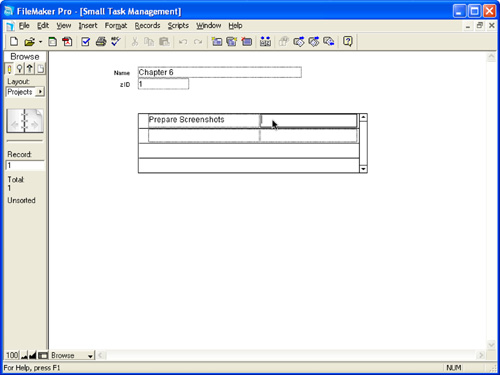
You can add one more feature to the portal to increase its usability: You can add a widget so that you can go to the related record. In Layout mode, select a widget from a Starter Solution or create one yourself and paste it into the portal row as shown in Figure 6.15. Any graphic will do—at this point it is merely an image with no functionality.
Figure 6.15. Add a widget to the portal row.
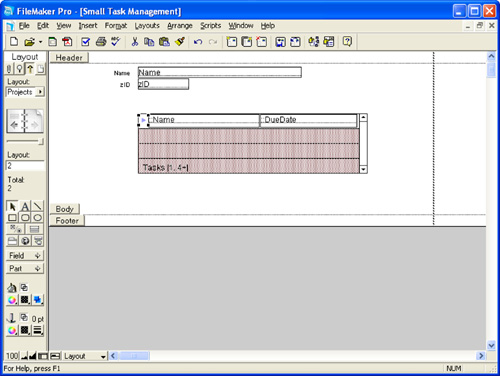
With the widget selected, choose Button Setup from the Format menu to open the dialog shown in Figure 6.16.
Figure 6.16. Use the Button Setup dialog to implement a button.
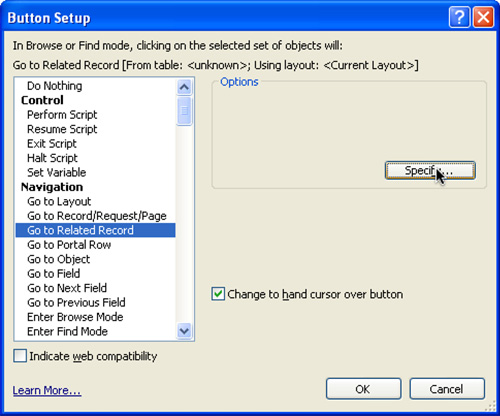
Choose Go to Related Record for the widget’s action as shown in Figure 6.16. Click Specify to open the Go to Related Record Options dialog shown in Figure 6.17.
Figure 6.17. Set the table and layout to go to.
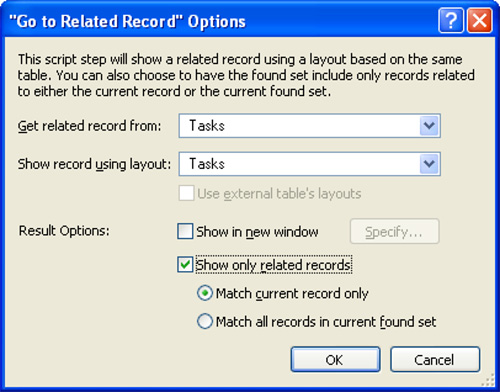
You will want to display records from the Tasks table. You can choose the layout to use (there is only one at this point, the default Tasks layout). Make certain that you use the check box at the bottom to show only related records.
Back in Browse mode, you will see your widget in the portal row; it will also be in the next (empty) row at the bottom of the portal as shown in Figure 6.18. If you click the widget in the first row (where you have entered data), you should go to the related Tasks record using the Tasks layout.
Figure 6.18. The widget lets you move to a related record in its own layout.
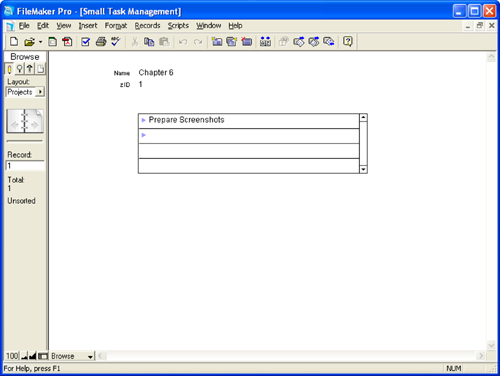
You have implemented a relationship in the database and implemented half the navigation needed to move around the relationship.
Working with Related Parent Data in a Child File
In the Tasks layout, you can make two improvements that will complete the process. First, add a merge field (Insert->Merge Field) in the header of the layout. From the Select Field dialog shown in Figure 6.19, select Name from the Projects table.
Figure 6.19. Add a merge field with the name of the related Projects record.
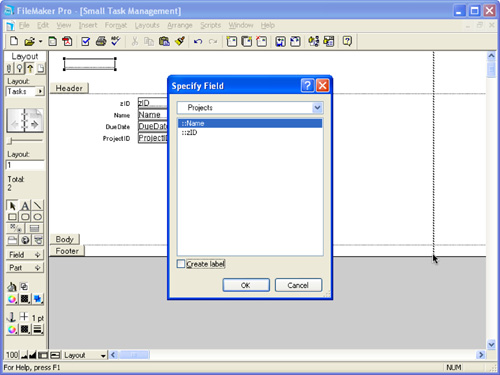
You can select the merge field and make it clickable by choosing Format->Button Setup. Repeat the process you used for the widget, but this time go to the related Projects record (you are already viewing the Tasks record), and use the Projects layout.
As shown in Figure 6.20, you now have the ability to move back and forth between projects and tasks.
Figure 6.20. The Tasks layout now has a link to the related Project.
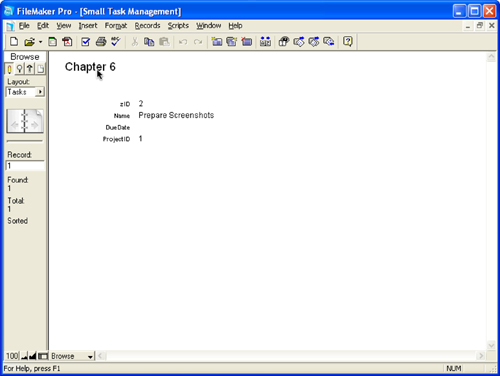
Creating a Many-to-Many Relationship
The preceding sections introduced you to most of FileMaker’s fundamental tools for working with multiple related tables. Now it’s time to extend those concepts and see how to use them to create a many-to-many relationship structure.
Building the Structure
As described in the previous chapter, a many-to-many relationship requires a join table. You have to add two tables to the Relationships Graph to implement a many-to-many relationship between tasks and contacts. The first is a Contacts table, which you can create exactly as you did the Projects and Tasks table. For now, it is sufficient to give it a zID and a Name field. Then create an Assignments table. This is the join table, and it needs three fields: its own zID field, a TaskID field, and a Contact ID field.
In the Manage Database dialog, create relationships between the Assignments table and the Contacts and Tasks tables. The process is the same as it was for relating Tasks to Projects. Your Relationships Graph should look like Figure 6.21 (subject to spacing variations).
Figure 6.21. Add relationships for the join table.
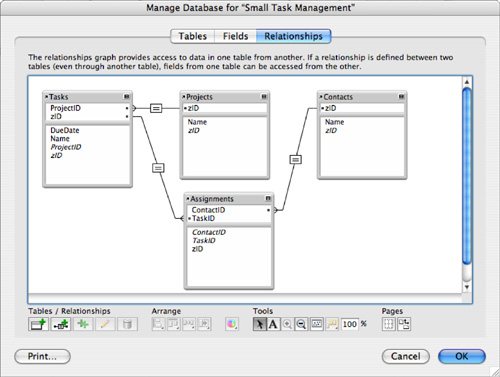
Creating Value Lists
You can use value lists to let users choose the values for the fields in the Assignments table. This is a good idea because the table itself uses the meaningless ID numbers. To create a value list, choose Manage->Value Lists from the File menu. You must have created the Contacts and Tasks table to complete this step. As shown in Figure 6.22, you first open the database file’s Manage Value List dialog.
Figure 6.22. Manage the value lists.
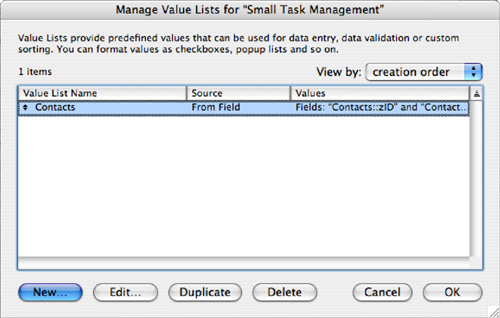
If you click Create or Edit, you open the next dialog, the Edit Value List dialog shown in Figure 6.23. You want to use data from a field, so use the first radio button as shown here.
Figure 6.23. Use data from a field.

On the Specify Fields dialog shown in Figure 6.24, choose the zID field from Contacts. Choose to show data from a second field—the Name field in Contacts—at the right of the dialog. Sort the data on the second field. Create value lists for Tasks in the same way.
Figure 6.24. Choose the zID and Name fields.
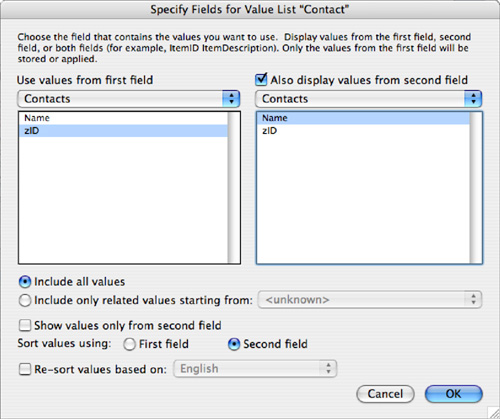
Designing the Interface
FileMaker Pro has created an Assignments layout for you automatically. You can modify that layout to make it more user friendly. The first thing to do is to make the ContactID and TaskID fields pop up menus using the value lists that you just created. Select the ContactID field in the default layout, and set it to use the Contacts value list as a pop-up menu as shown in Figure 6.25.
Figure 6.25. Use the value list for data entry.
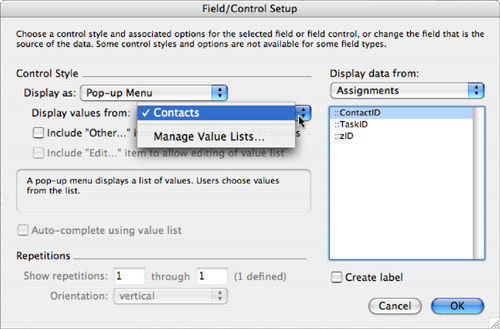
If you add a portal onto Tasks (as you did before), and if you add a field or merge field for the related Projects name field, your interface might look like Figure 6.26.
Figure 6.26. Your basic join table and its interface are complete.

You will find out more about relationships and layouts throughout this book. The principles are quite simple. It is important to remember that, compared to pre–FileMaker 7 databases, relationships can span many tables in the Relationships Graph. As long as a path can be found between two tables, they are related and you can use the relationship to construct portals and related fields.
As you build layouts, it is frequently a good idea to implement both sides of navigation—from a parent to child records (frequently using portals) and from a child record to its parent (with a widget—often in a portal row—that uses the Go to Related Record action). If you don’t do this, you might inadvertently construct traps that a user cannot easily get out of.
Another tip to remember is that frequently (but not always) it is the join table that should be the base table for a layout that will show a many-to-many relationship. Although the join table normally stays in the background, it has the information about both sides of the relationship.
Rapid Multitable Development
Working with the complex database schemas of a multitable file, or a solution composed of several such files, can sometimes be daunting. Using FileMaker Pro 9 Advanced, it’s now possible to import the definitions for multiple tables from one file to another. This schema import does not import any data, only the table and field definitions for selected tables. If you like to add a standard set of tables to most of your solutions (utility tables, logging tables, and resource tables), it’s now as simple as importing the table schemas from one file to another. It’s also possible to copy and paste table definitions, between or within files.
Additionally, the same is now also true of field definitions. They can be copied and pasted, either between files or within files, allowing you to quickly reuse blocks of standard fields. The enhancements extend to ScriptMaker as well, where you can now copy and paste scripts and script steps with ease.
All these new features are particularly useful in certain scenarios involving conversion from FileMaker 6 or earlier to FileMaker 9. If you’re attempting to consolidate many converted files into a single file, the capability to copy or import tables is a huge timesaver.
![]() For an additional discussion of conversion issues, see “Converting Systems from Previous Versions of FileMaker Pro,” p. 581.
For an additional discussion of conversion issues, see “Converting Systems from Previous Versions of FileMaker Pro,” p. 581.
 Troubleshooting
Troubleshooting
Repeating Portals
I’ve created a portal, but instead of seeing a set of different records, I see that every row of the portal shows exactly the same data.
This indicates a mismatch of table occurrences. Specifically, it suggests that although the portal is set to look at records from table occurrence A, the fields you’ve chosen to display in the portal are actually from table occurrence B. Because it’s possible to have several different table occurrences based on the same underlying table, it’s possible to see the same field list for several different table occurrences. Nevertheless, if the portal and the fields displayed in it draw from different table occurrences, you probably won’t get a meaningful display even if all the different table occurrences are based on the same underlying table.
Accidental Delete Restrictions
I set up a cascade-delete relationship between my Customer table and my Invoice table so that when I delete a customer, all related invoices are deleted as well. But when I try to delete a customer, it tells me I don’t have sufficient privileges. I checked my privileges and I do have delete privileges in the Customer table.
Check to make sure that you have delete privileges on the Invoice table as well. To perform a delete operation successfully in FileMaker, a user needs delete access to any and all records to be deleted. If you have delete privileges for Customer but not for Invoice, the entire deletion operation is forbidden.
